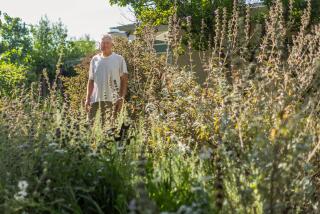Providing Bird Homes Away From Home
- Share via
Dick Purvis has the worst luck with tenants. The Anaheim resident has more than 100 houses scattered throughout Orange County, each built by himself, and he’s always having to go to each one and clean it out when it’s empty so a new family can move in.
It’s not easy being a landlord, especially when you’re dealing with tenants like his--bluebirds.
“They don’t like to reuse nests,” says Purvis, an electrical engineer with McDonnell Douglas in Huntington Beach. “They’ll build a new nest even though there may be a perfectly good one sitting inside already. After two or three nests, the house is full and has to be cleaned out if any more bluebirds are going to use it again.”
Purvis is a member of the Santa Ana-based Sea & Sage Audubon Society, a 2,700-member group that is affiliated with the National Audubon Society, and is one of many local residents who have taken an interest in the county’s wild bird population. Many homeowners are finding that attracting birds to their property is a way to learn more about nature and give their home an added, altruistic value as a bird haven.
Besides setting out feeders in his yard, for the past six years Purvis has been spending his spare time in the garage turning out bluebird houses made from fence siding and setting them in parts of Orange County where the bluebirds will congregate.
“They roam open savanna areas like golf courses and cemeteries, and they stay away from urban areas. They’re what’s known as ‘cavity nesters,’ meaning they need a hollow space in which to nest, and there aren’t many places like that around Orange County,” says Purvis.
He uses simple, rough-hewn redwood or cedar for his bluebird houses, which measure only 16 square inches inside. He takes special care with the size of the entrance hole. “I make it about 1 1/2 inches around, which is too small for starlings to use.”
Starlings are known as the bullies of the local bird world. “They’re big, mean and tough,” he says.
Birds often found in local back yards are house sparrows, finches, mockingbirds, California towhees, spotted and morning doves, hummingbirds and scrub jays. Robins can show up after a shower looking for worms and in the spring gold finches, small bright yellow birds with a black cap, might stop by after vacationing in Mexico.
To get your back yard noticed, you’ll need a feeder. “Using a platform feeder, which is basically an open box or tray, attracts the most birds because of the variety of seed available,” says Nancy Kenyon of Irvine, a member of Sea & Sage.
“You can use wild bird seed that you can get in pet stores or nurseries. I add peanuts and sunflower seeds.”
Such Birds as orioles and California thrashers are attracted to fruit. “You might take a wooden plank, nail some orange halves on it and put it in a tree,” says Richard Kust, president of Sea & Sage. “They like the juice, and the insects attracted by the juice will bring in even more birds.”
Hummingbird feeders, which are filled with a mixture of one part sugar to three parts water, have a reputation for saving many of these birds in Northern California during last December’s cold snap. “Since so many of the local flowers had died, the feeders were the hummingbird’s main source of food,” Kust says.
“The way your yard is landscaped affects the birds,” Kenyon says. “They like shrubbery of different levels, low, high and trees, which doesn’t always fit the perfectly manicured yard. Native plants also attract birds, such as shrubs like toyon and lemonade berry.”
Birds are also attracted to water, such as in birdbaths, and they especially love the running water of a fountain.
If you’re lucky enough to have attracted a nest in a tree of shrub, it’s OK to observe, but not too close. “If you get too close to a hummingbird’s nest, it will buzz right past your face as a warning,” Kust says.
Should you find a young bird that’s fallen from its nest, you can put it back, contrary to the old wives’ tale. “They say that the mother will smell the human scent on the bird and not feed it,” Kenyon says. “But that’s not true because birds can’t smell.”
“If the nest is too high and you can’t put it back, try to put the bird near enough to the nest so that the parent will see it and feed it,” Kust says.
Feeders should be cleaned regularly and hummingbird feeders washed out with bleach to help prevent germs from being spread among the bird population.
While birds can usually get along without human help, feeders provide “that extra margin of safety,” Kust says. “The bird is a little healthier, a little stronger because of the food we put out for it.”
More to Read
Sign up for Essential California
The most important California stories and recommendations in your inbox every morning.
You may occasionally receive promotional content from the Los Angeles Times.













